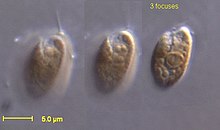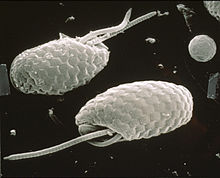Cryptophyceae
This article needs additional citations for verification. (August 2010) |
| Cryptophytes | |
|---|---|

| |
| Rhodomonas salina | |
Eukaryota )
| |
| Domain: | Eukaryota |
| (unranked): | |
| Superclass: | |
| Class: | Cryptophyceae
|
| Orders | |
| |
| Synonyms | |
| |
The cryptophyceae are a class of
Some exhibit
Characteristics
Cryptophytes are distinguished by the presence of characteristic extrusomes called ejectosomes or ejectisomes, which consist of two connected spiral ribbons held under tension.[4] If the cells are irritated either by mechanical, chemical or light stress, they discharge, propelling the cell in a zig-zag course away from the disturbance. Large ejectosomes, visible under the light microscope, are associated with the pocket; smaller ones occur underneath the periplast, the cryptophyte-specific cell surrounding.[5][6]
Except for
A few cryptophytes, such as
The group have evolved a whole range of light-absorbing pigments, called phycobilins, which are able to absorb wavelengths that are not accessible to other plants or algae, allowing them to live in a variety of different ecological niches.[9] An ability that originates from the evolution of a unique light‐harvesting antenna complex derived from two relict parts of the red algal phycobilisome, which was completely dismantled during the endosymbiotic process.[10]
While cryptophytes are usually seen as asexual, sexual reproductions do occur; both haploid and diploid forms have been found. The two species Teleaulax amphioxeia and Plagioselmis prolonga are now considered to be the same species, where T. amphioxeia is the diploid form and P. prolonga is the haploid form. The diploid form is most common when there are more nutrients in the water. Two haploid cells will often fuse to form a diploid cell, mixing their genes.[11]
Classification

The first mention of cryptophytes appears to have been made by
One suggested grouping is as follows: (1)
- Class Cryptophyceae Fritsch 1937 [Cryptomonadea Stein 1878 emend. Schoenichen 1925]
- Genus Wysotzkia Lemmermann 1899
- Genus Urgorri Laza-Martinez 2012
- Order TetragonidialesKristiansen 1992
- Family Tetragonidiaceae Bourelly ex Silva1980
- Genus BjornbergiellaBicudo 1966
- Genus Tetragonidium Pascher 1914
- Genus
- Family Tetragonidiaceae Bourelly ex Silva1980
- Order Pyrenomonadales Novarino & Lucas 1993
- Family Baffinellaceae Daugbjerg & Norlin 2018[16]
- Genus Baffinella Norlin & Daugbjerg 2018
- Family Chroomonadaceae Clay, Cugrens & Lee 1999
- Genus ?Smithimastix Skvortzov 1969 [Smithiella Skvortzov 1968 nom. illeg.]
- Genus Chroomonas Hansgirg 1885
- Genus Falcomonas Hill 1991
- Genus Hemiselmis Parke 1949
- Genus KommaHill 1991
- Genus Nodeana Skvortzov 1968
- Genus Planonephros Christensen 1978
- Genus Protochrysis Pascher 1911
- Family Geminigeraceae Clay, Cugrens & Lee 1999
- Genus Geminigera Hill 1991
- Genus Guillardia Hill & Wetherbee 1990
- Genus HanusiaDeane et al. 1998 non Cripps 1989]
- Genus Plagioselmis Butcher 1967 ex Novarino, Lucas & Morrall 1994
- Genus TeleaulaxHill 1991
- Family Pyrenomonadaceae Novarino & Lucas 1993
- Genus ProteomonasHill & Wetherbee 1986
- Genus Rhinomonas Hill & Wetherbee 1988
- Genus Rhodomonas Karsten 1898 [Pyrenomonas Santore 1984]
- Genus Storeatula Hill 1991
- Genus
- Family Baffinellaceae Daugbjerg & Norlin 2018[16]
- Order Cryptomonadales Pascher 1913
- Family ?Butschliellaceae Skvortzov 1968
- Genus Butschliella Skvortzov 1968
- Genus Skvortzoviella Bourelly 1970
- Family ?Cyathomonadaceae Pringsheim 1944
- Genus Cyathomonas de Fromentel 1874
- Family ?Hilleaceae Pascher 1967
- Genus Calkinsiella Skvortzov 1969
- Genus Hillea Schiller 1925
- Family ?Pleuromastigaceae Bourrelly ex Silva 1980
- Genus ?Opisthostigma Scherfffel 1911
- Genus Pleuromastix Scherffel 1912 non Namyslowski 1913
- Genus Xanthodiscus Schewiakoff 1892
- Family CryptochrysidaceaePascher 1931]
- Genus ?Chilomonas Ehrenberg 1831
- Genus ?Protocryptochrysis Skvortzov 1969
- Genus Cryptella Pascher 1929
- Genus Cryptochloris Schiller 1925
- Genus Cryptochrysis Pascher 1911
- Genus CampylomonasHill 1991]
- Genus Cyanomastix Lackey 1936
- Genus Isoselmis Butcher 1967
- Genus Kisselevia Skvortzov 1969
- Genus Meyeriella Skvortzov 1968
- Genus Olivamonas Skvortzov 1969
- Genus Protocryptomonas Skvortzov 1969 ex Bicudo 1989
- Family ?Butschliellaceae Skvortzov 1968
References
- PMID 18397952.
- ^ Cryptophyceae - :: Algaebase
- ^ "Cryptophyta - the cryptomonads". Archived from the original on 2011-06-10. Retrieved 2009-06-02.
- ISBN 9780321559654.
- PMID 6155157.
- PMID 6470985.
- PMID 11323671.
- PMID 10430868.
- ^ Callier, Viviane (23 October 2019). "This Type of Algae Absorbs More Light for Photosynthesis Than Other Plants". Smithsonian Magazine.
- ^ Molecular structures reveal the origin of spectral variation in cryptophyte light harvesting antenna proteins
- ^ Dimorphism in cryptophytes—The case of Teleaulax amphioxeia/Plagioselmis prolonga and its ecological implications
- ^ Novarino, G. (2012). "Cryptomonad taxonomy in the 21st century: The first 200 years". Phycological Reports: Current Advances in Algal Taxonomy and Its Applications: Phylogenetic, Ecological and Applied Perspective: 19–52. Retrieved 2018-10-16.
- PMID 21810989.
- PMID 26817772.
- ^ "Cryptomonads". Retrieved 2009-06-24.
- S2CID 51718360. Archived from the original(PDF) on 2018-10-12. Retrieved 2019-05-26.
